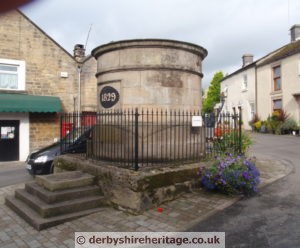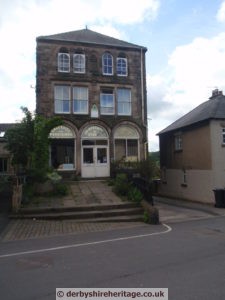Youlgrave or Youlgreave
Youlgrave was recorded as ‘Giolgrave’ in the Domesday Book of 1086 as belonging to Henry de Ferrers and being worth sixteen shillings.
The two most common spellings of the village name are Youlgreave and Youlgrave. A sign at Friden is spelt Youlgreave but the sign on the road up from Alport is spelt Youlgrave. OS Explorer OL24 is spelt Youlgreave but local people appear to use Youlgrave and this is also how the name is pronounced. See Youlgrave or Youlgreave for a compiled list of alternative spellings.
Origins of the village nickname of Pommy are uncertain but thought to probably be connected with the local band. When instruments were first purchased, only a few members of the band knew any music, so parades were not particularly tuneful, but more of a repetitious ‘Pom, pom, pom’. Another version of Pommy is of a pig resting on a wall serenading the band as it passed by.
As with many other villages in the area Youlgrave was heavily involved in the industry. Mawstone Mine even re-opened after the First World War in anticipation of increased demand, only to cease production permanently in 1932 after an explosion killed five of the six miners working underground and three of the rescue party.
In the centre of the market place is a huge circular water tank or conduit head, known locally as The Fountain. Since 1829 this supplied soft water to the villagers, initially at an annual charge of 6d. It was built following a campaign by the ‘Friendly Society of Women’, who demanded a cleaner, healthier and more efficient supply of water and was infinitely better than carrying the water up from Bradford Dale.
Erected in 1829, known locally as “The Fountain” and having a capacity of 1500 gallons of water. It was built, from local gritstone, by Edward Twyford at a cost of £31.10s., to provide a head of water when a public supply was first brought to the village. The height of the first spring was 630 feet above sea level and the base of the tank was 605 feet, thus allowing a 25 feet head of water. The cost to the villagers was 6d. per annum and water could be obtained between 6 am. and 6 pm. daily when access to the single tap was unlocked by the overseer. The erection of the “fountain” marked the culmination of a campaign by local women, led by Miss Hannah Bowman, who had previously been obliged to lug water up from the River Bradford, which was really too hard for wash day. Softer water was piped from the Mawstone Spring, across the valley. In later years, water was piped to street taps and eventually into people’s homes.
The supply deteriorated due to the rotting and collapse of the pipe, and it was decided to lay a new one, this time from a different spring in Bleakley Wood (SK.217629) near to Mawstone Spring. The cost of this was estimated as £400, a considerable sum for a small village to raise in the 1860’s. Four local benefactors came to the rescue and the men in the village were required to do the digging, ‘and he who could not do his share paid another man to do it for him’. On 27th July 1869, a second opening ceremony was held at the same stone tank, followed by celebrations on a grand scale. There was a public dinner for 300 persons in the new schoolroom, 400 children marched behind the Matlock Brass Band, and it all finished with a great public tea.
The site of the conduit was originally occupied by a Saxon cross.
Thimble Hall was originally a one-up, one-down cottage with a ladder for a staircase; no bathroom or kitchen nor even running water and said to have been home to a family of eight around a hundred years ago. A Guinness World Records Certificate names Thimble Hall in Youlgrave as ‘the world’s smallest detached house’ at 11ft 10 in x 10 ft 3 in and 12 ft 2 in high.
The Youlgrave Cooperative permitted members to receive goods on credit, paying for them when circumstances improved. It was built in 1887 on the site of the original village school of 1762. Except for the very poorest, chosen by the school committee, the pupils of the school paid 1d. per week.. The old store is now a Youth Hostel but the names of departments are kept on dormitory doors. A few years after the Cooperative Store closed it featured in the film “The Virgin and the Gipsy”, after the novel by D.H. Lawrence, which was made in the village and referred to as Congreave in the novel.. The building is now owned by the Youth Hostel Association.
The parish church of All Saints is the second largest in the Peak District after Tideswell. It has several fine tombs, a Norman font and an unusual carved 12th century figure of a pilgrim with staff and wallet. The stained glass East window was made by William Morris to a design by Edward Burne-Jones.

